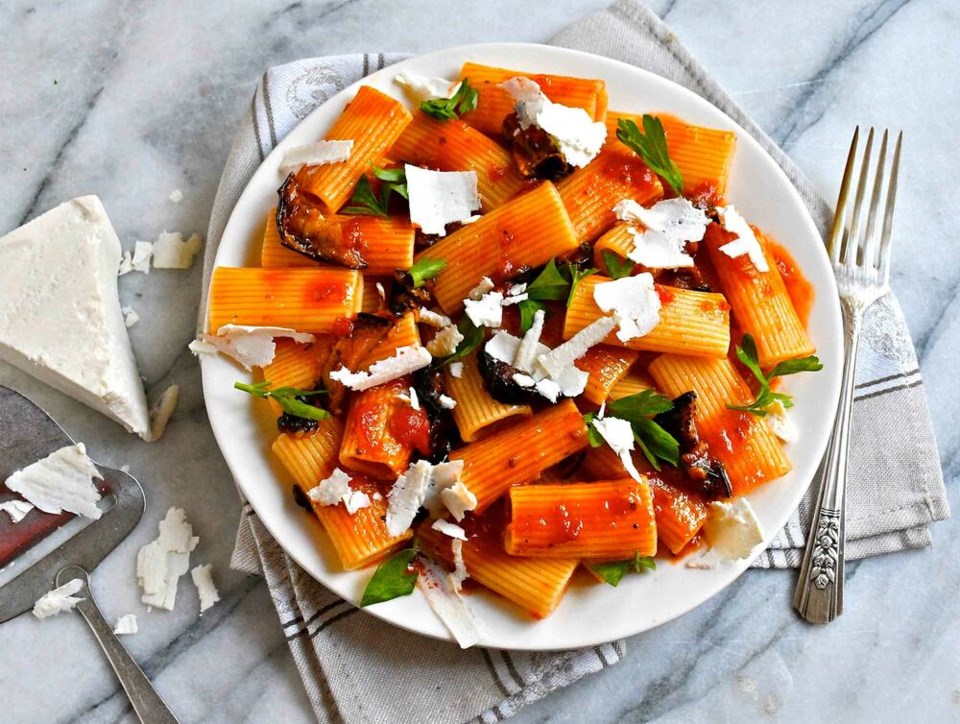I saw fine looking Island-grown eggplant at a food store the other day and it inspired me to make pasta alla Norma. It’s an Italian dish incorporating eggplant and a few other key ingredients believed to have been first prepared in the Sicilian city of Catania.
If you are wondering why it’s called “Norma,” the Italian food website La Cuicina Italiana () suggests two possibilities. One story goes that Catanese composer/writer Nino Martoglio, who lived from 1870 to 1921, was having this pasta dish and loved it so much he called it Norma, the name of fellow Catania native Vincenzo Bellini’s opera. Lore says that when Martoglio was eating it he exclaimed “Chista è ‘na vera Norma!” Or, in English, “this is a true Norma!”
Another story says the dish got its name even earlier than that, noting that the pasta was created for Norma’s opening night, Dec. 26, 1831.
However it got its name, it became a very popular pasta dish in Sicily and eventually other parts of Italy and the world. Because it has been made for so long, I was not surprised to find variations on how it’s prepared, such as what type of pasta is used. Some recipes call for spaghetti, while many others call for tubular pasta, such as maccheroni, penne or rigatoni.
But most recipes for pasta alla Norma see eggplant fried in olive oil and added to a rich tomato mixture/sauce. Cooked pasta is then tossed in, and the dish is served, topped with a fresh herb, such as basil or parsley, and cheese.
That cheese, traditionally, is ricotta salata. It’s a salted, aged, pressed Sicilian-style of ricotta that has firm texture making it suitable for shaving into thin slices or grating. It’s not always easy to find, though (see note under my recipe), so some recipes for pasta alla Norma give the option to use other types of sheep milk-based cheese, such as Pecorino Romano.
Pasta alla Norma
This Sicilian-style pasta dish tastily combines tender, fried eggplant, rich tomato sauce, salty cheese and herbs.
Preparation time: 20 minutes
Cooking time: about 20 minutes
Makes: two servings
10 (about 1/2-inch thick, 2 1/2-inch diameter) slices of eggplant
• salt and freshly ground black pepper, to taste
3 Tbsp extra virgin olive oil, plus more, if needed
200 grams rigatoni (about 2 2/3 cups) or other tubular pasta
1 medium garlic clove, minced
1/4 tsp dried oregano, or taste
• pinch red pepper flakes
1 cup rich tomato sauce, passata di pomodoro or peeled, chopped, ripe fresh or canned tomatoes (see Note 1)
• shaved or grated ricotta salata, Pecorino Romano or Parmesan cheese, to taste (see Note 2)
• coarsely chopped Italian (flat leaf) parsley or torn fresh basil leaves, to taste
Bring a large pot of lightly salted water to a boil. While water is coming to temperature, pour 3 Tbsp olive oil into a large, 10-inch or similar-sized skillet set over medium heat. Season eggplant with salt and pepper, and then set in the skillet, in batches if needed, and fry until tender, about three to four minutes per side. During cooking, add more oil to skillet, if needed. When cooked, set eggplant on a cutting board.
Add garlic, pepper flakes and oregano to the skillet and cook until fragrant, about 30 seconds. Pour in the tomato sauce (or passata or chopped tomatoes), bring to a simmer, and then remove from the heat.
When water is boiling, and the pasta and cook until tender (check package for suggested cooking time). While pasta cooks, slice the eggplant into strips and add to the skillet with the tomato sauce.
When pasta is cooked, scoop out 1/3 cup of the pasta cooking water and set in a bowl. Now drain the pasta well.
Set the tomato sauce back over the heat and return to simmer. Toss in the pasta and pasta cooking water; season with salt and pepper. Divide pasta between two serving dishes, top with cheese and parsley (or basil), and serve.
Note 1: The locally made, fantastic tomato sauce I used when testing this recipe was Zambri’s House Made Tomato Sauce. It’s made by Victoria’s Zambri’s restaurant (). You can buy jars of it direct from the restaurant and at some smaller food stores. I bought it at the Old Farm Market in Oak Bay. If using passata di pomodoro, also called strained tomatoes, it’s sold in tall bottles in the pasta sauce aisle of supermarkets.
Note 2: You’ll find ricotta salata at some Italian/European food stores. I’ve seen it for sale in Oak Bay at Ottavio, 2272 Oak Bay Avenue.
Eric Akis is the author of eight cookbooks. His columns appear in the Life section Wednesday and Sunday.



